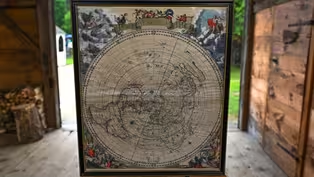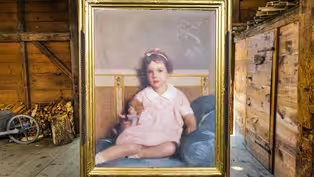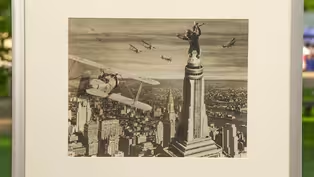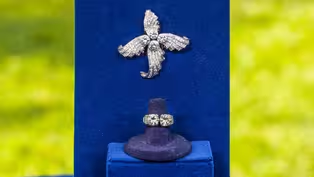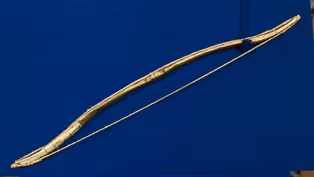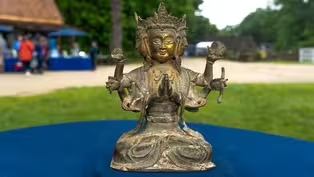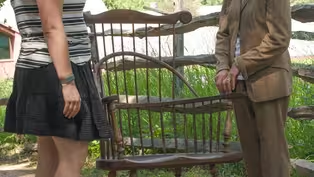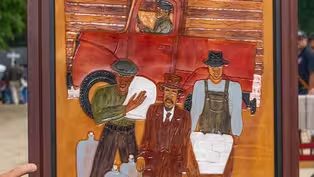
Old Sturbridge Village, Hour 2
Season 28 Episode 5 | 52m 25sVideo has Closed Captions
Old Sturbridge Village brings in new remarkable finds. One is $100,000 to $125,000!
Old Sturbridge Village brings in new remarkable finds, including a 1977 Pelé-signed soccer ball, a 1933 RKO King Kong Bachrach photo, and Winfred Rembert’s Moonshiners painting, ca. 2001. Guess the top $100,000 to $125,000 find.
Problems playing video? | Closed Captioning Feedback
Problems playing video? | Closed Captioning Feedback
Funding for ANTIQUES ROADSHOW is provided by Ancestry and American Cruise Lines. Additional funding is provided by public television viewers.

Old Sturbridge Village, Hour 2
Season 28 Episode 5 | 52m 25sVideo has Closed Captions
Old Sturbridge Village brings in new remarkable finds, including a 1977 Pelé-signed soccer ball, a 1933 RKO King Kong Bachrach photo, and Winfred Rembert’s Moonshiners painting, ca. 2001. Guess the top $100,000 to $125,000 find.
Problems playing video? | Closed Captioning Feedback
How to Watch Antiques Roadshow
Antiques Roadshow is available to stream on pbs.org and the free PBS App, available on iPhone, Apple TV, Android TV, Android smartphones, Amazon Fire TV, Amazon Fire Tablet, Roku, Samsung Smart TV, and Vizio.
Buy Now
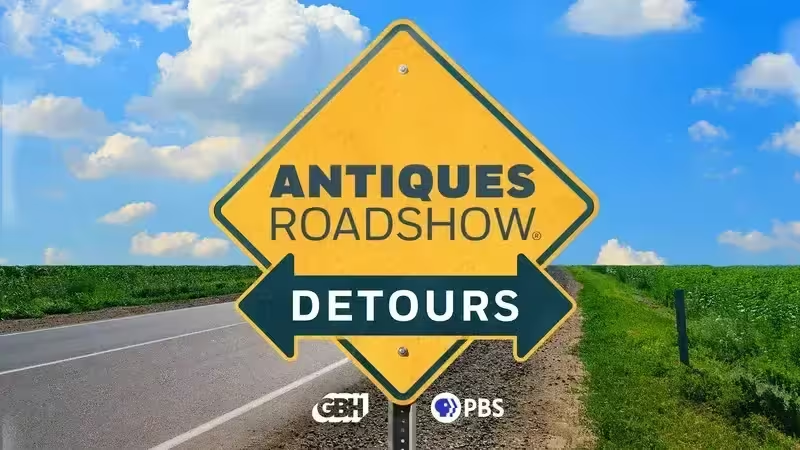
ANTIQUES ROADSHOW DETOURS
Ever wondered what happens to the treasures featured on America’s beloved ANTIQUES ROADSHOW after the cameras leave town? Host Adam Monahan tracks down the juicy afterlives of your favorite finds from PBS’s hit series.Providing Support for PBS.org
Learn Moreabout PBS online sponsorship♪ ♪ CORAL PEÑA: "Roadshow" is stepping back in time at the Old Sturbridge Village in Massachusetts.
I know you'd never sell your mother.
In my younger years, maybe, but not, not at this point.
(laughs) Wow, yeah, that's amazing.
Ooh, I just got a chill.
♪ ♪ ♪ ♪ PEÑA: Old Sturbridge Village is the largest outdoor history museum in the Northeast.
The 40 original and reproduction buildings on site are like individual time capsules that together depict a rural New England town of the 1830s.
See the home of two generations of highly successful businessmen built around 1796: the Salem Towne House, moved from Charlton, Massachusetts.
Check out the student-carved graffiti in the school desks of a district school from Candia, New Hampshire, built around 1810.
And, of course, there's a classic symbol of Vermont: a late-19th-century covered bridge, formerly of Dummerston, that was moved to the village in 1951.
Nearly 25 million tourists have visited Old Sturbridge Village since it opened in 1946.
The village can add about 3,000 more to its impressive tally after today's "Roadshow" event.
It's double-sided-- which one do you display?
I display the mountain view.
Excellent.
♪ ♪ GUEST: Pele's last game, he played half for the Santos, half for Cosmos.
My mother was able to get me into the tunnel where the players were lining up.
Pele was there, and it was a different world, different era.
He was able to get the ball, sign it for us, and I took some pictures with him.
And then I've had the ball since.
APPRAISER: Amazing, and, uh, this was at the Meadowlands.
Yeah.
I was at the game, too.
How about that?
Pele's, international icon.
The Cosmos were a soccer team in New Jersey in 1970s, 1980s, part of the North American Soccer League.
And when Pele came to North America to play for the Cosmos, it was a huge deal.
It was, like, the biggest deal.
Yeah.
Pele signed a lot of stuff over the years.
The fact that it's not signed to you directly actually gives it more value.
Oh.
And today, a ball like this, vintage signature, $2,000 to $3,000.
Wow, wow.
(chuckles) Oh.
That's great.
Yeah.
It's good to know-- but you know what?
Yeah.
I'll never sell it.
No...
It's going to be with me for a long time.
And then with this guy.
And then with you, right?
Beautiful piece.
GUEST: I got it from a gentleman in London.
He owned a poster gallery.
And I was looking at posters, and it was, it struck me because it was a photograph, and I thought that was kind of an odd thing.
What was it about this image that you had to have?
Well, I love the movie "King Kong," and I was living in New York at the time, and it was just the quintessential image of Kong and the Empire State Building.
So I, I just thought it would be great in my apartment.
And the Chrysler Building, and it's just... And the Chrysler, yeah.
It is pretty fantastic.
The other wonderful thing about this image, apart from it showing New York and some of the famous buildings-- he's on the Empire State Building.
This is obviously the climax of the film, where Kong is just trying to get away, and he's...
The, the famous moment where he's swatting at the planes who are trying to attack him and dislodge him from the Empire State Building.
The whole film really builds to this scene.
Yeah.
What did you pay for it?
I paid, if I recall, about $900 for it.
And this was how long ago?
22 years ago.
What are you most interested in knowing today?
Just if it's increased in value, and certainly if it is original.
Well, this is not only original, this is so chock-full of information on the back of this photograph.
This is a special photograph.
Someone asked me if this was a still from the film, and the answer is, well, yes, but no.
(laughs) It, it is a scene from the film, but a still, when we use that term, we're usually referring to the eight-by-ten black and white photographs that came out.
They were used for publicity for the film.
Yes, yes.
This is not that.
This is a much larger format.
It's a ten-and-a-half by about 13-and-three-quarter-inch image, a matte vintage print.
And what we can learn from the back of this is that this is one of the magical images that was supplied by the production of "King Kong" to "Shadowplay" magazine for their March of 1933 issue.
They selected a few of the most extraordinary images in the film that they felt were going to promote the film the best.
Right.
And they gave "Shadowplay" magazine an exclusive.
So they would be the only magazine to get these pre-release images from "King Kong."
The magazine came out in the beginning of March.
The film came out in late March.
So this was everyone's first sneak peek at this extraordinary wonder of a film.
We also have the photographer's stamp from Ernest Bachrach on the back of the picture.
He's a famous photographer who took some of these images for the film.
We have the March 1933 date stamp.
We have handwritten notations stating "Shadowplay magazine, March 1933."
We have what we call a snipe, which is a typed little strip of paper they would put on the back of these pictures when they would send them out for the press.
And it gives a brief synopsis of what we're looking at in the image.
Because of all of that, this elevates it so far beyond a standard still.
It, it becomes, really, a contemporary relic of this film.
And paper associated with this film is incredibly rare.
If you're a poster collector, you know "King Kong" posters are quite expensive.
(chuckles) Yes.
A few of these have come up.
The most recent one that came up was in 2009, and it was King Kong at the gates, which is one of the poster images that's very popular.
Right.
Another great image.
I think yours is just as good, if not better.
This is that key moment in the film.
This is the, the climax of all the action.
Mm-hmm.
The one that came up in 2009 sold for over $6,500.
Really.
I think if yours came up at auction, conservative estimate would be $5,000 to $7,000.
Wow-- wow.
(chuckles) That's amazing, just amazing.
It's, uh, it's one of my favorite things.
I've, I've had it in my office for many, many years, and I just, I never get tired of looking at it.
I'm floored that it went up that much, that's incredible.
It's funny, because at the time, I remember I was living in an apartment in New York, and $900 to me was a lot of money.
It was my rent, but I just, I couldn't resist.
You're a true collector.
So... (laughs) My mom gave it to me, and I think it was probably around '62 to '64, for a birthday present.
I was more of a stuffed animal girl.
(chuckling): So a lot of this stuff in here is still in really good condition, 'cause I really didn't play with it.
(laughs): She's been in the closet for a long time.
It does smell a little musty, so I'm closing it.
(laughs) It took my whole paycheck-- I was in the Navy.
And, uh, I surfed, uh, North Shore, Hawaii, with it.
That's, that's the only place it's ever surfed.
I did try to take it to Nauset Beach at the Cape once, and I looked at the waves and I laughed and I went home.
(laughing) (exclaiming) Not enough.
It's not a light board, I'll tell you.
Right there, right there, boom.
Nailed it!
(laughing) GUEST: It's my mom, painted when she was four years old by an artist named Adelaide Chase from Boston.
What I heard growing up was, everybody in Boston had their portraits painted by Adelaide Chase at one period in time.
We have a portrait of her mother, and, um, on my dad's side, two portraits, yeah.
Also painted by her.
Yes, right.
So there are four in the whole family.
Yeah.
That's, that's really kind of amazing.
Yeah, yeah.
Two sides of the family.
Yeah.
She was a very important society painter in Boston... Yeah, yeah.
...uh, in the early 20th century.
Uh, she was born in 1868 in Boston, and she was born into a very artistic family.
Right.
Her mother was a pianist.
Right.
Her dad, uh, J. Foxcroft Cole, was a painter...
Right.
...and was her first unofficial teacher.
Purportedly, as a child, she posed for Winslow Homer, who was a friend of Cole's.
Yes.
So from a very early age, she was just surrounded by art and music.
Yeah.
And in Boston at the end of the 19th century, you wanted to train with Frank Benson... Yup.
...and Edmund Tarbell.
Mm-hmm.
And she trained with them both at the Boston Museum School.
Right.
And then, as many Boston painters did, uh, she went off to, uh, Paris and the Académie Julian, and got experience there.
And she came back to be one of the preeminent portrait painters in Boston, as you said.
Yeah.
One of the things I really love about her is, uh, she got married in 1892 to William Chester Chase.
You thought I was going to say William Merritt Chase, the painter, but no.
(chuckles) William Chester Chase, who was an architect.
Right.
But he, too, was in the arts.
And so even though she got married, she continued to work as a married woman...
Right.
...throughout her career.
Mm-hmm.
And that was very unusual at the time.
And the style is very Boston School.
Uh-huh.
It's, it's exactly the sort of American Impressionist approach.
A slightly more subtle palette than some of the other artists at the time.
Yeah, yeah.
But still clearly impressionistic and just beautifully captured textures in clothing, in objects, in flesh.
And that's why she was so sought after.
I have to ask... Uh-huh.
Do you still have the doll?
I do have the doll!
You do?
It's still in the family?
(laughs): Yes, yes.
(exclaims) Yeah.
The other thing we should talk about, since we're talking Boston... Mm-hmm.
....is this wonderful, uh, carved frame.
Oh.
So when we look at the back, it's actually signed "Thulin, 1932."
When was the portrait done?
Well, she was four, I think she was four, which would have been 1931, but, yeah.
So that, that works.
Yeah, yeah.
So Thulin was a very important frame maker.
In Boston, around 1903... Uh-huh.
...an artist by the name Hermann Dudley Murphy joined together with Walfred Thulin, as well as Charles Prendergast, to make a frame shop.
Oh, uh-huh.
And they created these beautiful hand-carved frames that are very valuable in and of their own right.
Oh, gee, uh-huh.
And, not that you would ever want to separate it, because it's, it's...
Right.
...the quintessential Boston package.
Mm-hmm.
I know you would never sell your mother.
Right.
(both laugh) Never!
No, in my younger years, maybe, but not, not at this point.
(laughs) So for insurance purposes, I'd insure it for $32,000.
No, sir!
Yes, sir!
(laughs) Jeesum Crow!
(laughs) You knew your mom was a winner.
(laughs): Yeah.
Gee, she did always say she was, so... (laughs) PEÑA: "Antiques Roadshow" knows that every object has a story, even everyday items.
This eclectic quilt was made by Susannah Allen Anderson Howard around 1840 for her marriage to Emery Howard.
Susannah was born in 1813 and lived in Ware, Massachusetts.
She became an orphan at the age of 14, and raised her two younger brothers after her parents' passing.
A creative quilter, she used many different techniques and patterns in this unique example.
It's a statue that was in my family, and, uh, just never was given permission to leave the house.
My parents recently passed, last year, 2022, and I have it now at my house.
I'm the third generation to have it.
My grandfather, he had been in World War I and brought it home from someplace in Asia, I'm not really exactly sure.
And it sat on their fireplace mantel, and somebody started calling it "the Becky."
(laughs): Okay.
And so it's, it's the Becky, I have no idea... Becky's been in the family... About what year did it... Um... Well, I'm thinking, uh, World War I ended, what, 1918?
Okay.
So it came back just prior to 1918.
I can confirm that she is indeed Asian-- Chinese, specifically.
Ah!
And it makes me wonder if your grandfather was part of a Marine battalion in China, perhaps.
1918, or around that era, was a pretty tumultuous time in China.
Mm-hmm.
It was a period when the last dynasty had just crumbled unceremoniously.
And there were a period of warlords who had taken control of the country in those first few decades of the 20th century.
Hm.
In fact, the, the American Army was there in part to protect our embassy and American interests there.
This doesn't date from that era, though.
This is actually a relic from the Ming Dynasty.
So that is to say, in rough terms...
Okay!
...this is about 400 to 500 years old.
(laughs): Okay!
It was quite a long dynasty.
It spans from 1368 to 1644.
Wow.
And this particular bronze would have been made in the latter part of that dynasty.
Oh!
I think in the late 16th century, early 17th century.
Where has Becky lived, or, traditionally, in your parents' home?
Now I'm afraid to say.
(laughing) Please, do tell.
Yeah, it's, I mean, it lived, uh, in a bookcase kind of thing.
I guess my grandmother used to hide money in it or something?
(laughs): Okay.
And so there was a family story about how, if they wanted to go someplace, she would stuff money up in there, and she'd say, "Well, let's go ask Becky."
And she would pick the thing up and see what money was in there so they could go do whatever it was.
The method of casting leaves this hollow cavity there, so one could stuff money in there.
(laughing) Or, originally... Yeah?
...stuff prayer scrolls on the inside.
Oh, my gosh.
This is something that would have been made to go into a shrine.
This particular bodhisattva is a guardian figure.
Oh.
And it was one of several guardians that would have been cast in this proportion and put into a shrine or put into a temple.
So when this was acquired, let's say around 1918 or so... Yeah.
Again, this is a nation in a rebuilding phase.
Okay.
And objects like this were, were for sale.
This would have been originally a very sacred object, protected, left in a shrine.
Wow.
Wow.
And in this warlord period, some of what was sacred had to be converted into cash.
Okay.
And so it was common for visit, visiting dignitaries, visiting tourists, in some cases, even soldiers, to acquire object, objects like this and bring them back.
In China, throughout the Ming Dynasty, Buddhism was sort of spreading.
What was already in place in terms of spiritual traditions was the tradition of Taoism.
Mm-hmm.
And what's particularly interesting about this figure is that it's a Buddhist deva called Marici, who has a Taoist counterpart called Doumu.
So in the Ming Dynasty, there was a generally harmonious meeting of these two spiritual traditions.
I can point to a few of these attributes in the hands.
Mm-hmm.
The top one being the Chintamani, this wish-granting jewel, which is rooted in the Hindu tradition, and then through Buddhism.
And then this item, which is called a ruyi scepter... Mm-hmm.
It's missing the head right there... Oh.
...it's something that actually corresponds more to Chinese folk traditions and is a little more on the Taoist side.
It's really chock-full of symbolism.
Uh-huh.
The many heads represent omniscience, generally speaking.
The, the, the multiple arms represent omnipotence.
In, in terms of condition, there are some things that were once present in these hands that are, that are gone.
Uh-huh.
Uh-huh.
There are traces of some polychrome decoration, but what, what I think is, is really most striking is this beautiful gilding on the faces.
This would have been gilt in, in its entirety originally.
Oh!
Okay.
And where it's been held, where it's been moved around, the gilding is, is long gone.
It's a little worse for wear, but I think on the whole... Yeah.
...it presents beautifully.
It's really a terrific Buddhist and Taoist icon.
It's so distinctly Chinese.
Wow!
Becky...
Yes?
...or Marici, or Doumu...
Okay, uh-huh.
...or however we'd like to, to, to call this figure, fits into a marketplace right now that's very strong.
And I think at auction today, I'd put an auction estimate of $10,000 to $15,000.
(laughs): Okay, wow, all right.
That's amazing-- I had no idea, okay.
(laughs) That's incredible, thank you.
Jeez.
You're very welcome.
(laughs): Glad you could talk to Becky.
(laughs): Thank you so much.
You're very, very welcome.
Holy smokes, yeah.
This is a violin I played when I was a kid a few years ago, and my parents bought it from my violin teacher's father, who was a old Hungarian immigrant, and I know almost nothing about it.
PRODUCER: Do you still play?
Uh, n, not really, no.
(laughs) I really enjoyed it as a kid, but, you know, life gets in the way.
I figured someday life would get l, less busy and I would pick it up again.
This is a World War I air alarm?
Or gas alarm.
Okay.
Is what I know about it.
It's a little bit later than that-- it's between the wars.
Okay.
It's between World War I and World War II, and it is a gas alarm.
It's got a value of about $100.
Okay.
Have you ever cranked it before?
Um, we did a little bit earlier today, yeah.
You did?
Want to try it?
See if we can make it work?
Yeah.
(creaking) Pretty nasty, huh?
(both laughing) GUEST: This tarp is a piece from the Christo and Jeanne- Claude exhibition "The Gates" from Central Park in New York City.
And this covering was used in the preparation and unveiling of the exhibition.
One by one, they took these tarps off and released these curtains down.
So this is one of the tarps.
And I think the big thing that we're leaving out is, who's in this photo right here?
(laughs) Yeah, so, uh... (laughing) So I was there, so I was following a work crew, and I asked them, "Hey, can I open one?"
And they gave me the pole, and unzipped this tarp.
And afterwards, I was, like, "Is this something that I could keep as a memento and, and take this home?"
And they said, "Yeah, just, just take it home with you."
And I've had it ever since.
I think that is absolutely incredible.
And especially, being an art nerd, not only are you someone who got to witness this and see it at the time in New York in 2005, but you actually lived it.
That's right.
It was my mom's birthday, and she's a huge Christo fan.
And we went and we had this wonderful opportunity to do this all together, so...
When it comes to land installations, the first names that come to mind always for me are Christo and Jeanne-Claude.
They did "Surrounded Islands," the "Floating Piers."
They even covered the Arc de Triomphe.
And "The Gates" is right there, up there in their bodies of work, of being one of the most notable.
Even though this was first open to the public in February of 2005, there was a long road of getting there.
Christo and Jeanne-Claude first proposed to the city back in 1979, they were pushing to get this done.
It wasn't until 2004 they were able to start the installation.
Now, what did you refer to this wrap?
I believe they called it, like, a cocoon.
It was, like, the covering, the thing that the, the, the exhibition emerged from.
When the installation first opened up on February 12, there were 7,503 gates through Central Park, spanning 23 miles.
I wish I could have been there to live it.
I am so jealous of you right now.
I want to vicariously live through you.
Yeah.
There's over 5,000 tons of steel, over 300,000 feet of, uh, vinyl tubing and fabric.
It's just incredible, the organization and the work that goes into every one of their installations.
Now, the actual gates themselves were this lighter nylon fabric that was made to flow in the wind.
This is a heavier vinyl that was made as the protective element for the installation during transportation.
Now, we have it rolled up on the table because it is such a large piece of, uh, vinyl fabric here.
But do you know the dimensions of when you have it in your home?
I think it's marked with 14 foot, three inches, something like that.
Because it is the cocoon, it is part of the process.
It adds the performative element to the installation.
Conservatively, at auction, for a cocoon vinyl-wrapped covering, we feel it would be in the $2,000 to $3,000 range at auction.
Wow, yeah, that's amazing.
Uh, I just, I, I find it hard to believe, almost, uh, like...
It, it's just been, you know, in my apartment kind of kicking around.
♪ ♪ PEÑA: The Freeman farmhouse, built around 1815 in the town of Sturbridge, was moved to Old Sturbridge Village in 1951.
Pliny Freeman was a farmer who faced many ups and downs during his days in agriculture.
After farming two parcels of land elsewhere, Freeman finally had success at his third farm.
He paid $381 for the final farmstead, which consisted of a house, a barn, and about 37 acres of land.
I brought a tribal art doll that I know absolutely nothing about.
I collect European dolls, and one of my friends in the mid-'80s was one of the people who tried to bring dolls to stamps.
And the first time they tried, they were unsuccessful.
My understanding was that it was general antique dolls.
Yeah.
So they put their heads together and decided, "Let's try to do American-made dolls."
They pitched it again and they were successful.
So my friend owns several of the dolls that are in the stamps.
She was downsizing and asked me if I would like to buy some of her dolls.
And this one interested me, and I bought it from her.
She's a Plains Indian doll.
Yes.
And it's really a little difficult to discern.
The beadwork would say that she's probably Sioux.
And it's a child's, girl's doll, like a toy.
But it was also probably made by a, um, grandmother or a mother for her daughter or granddaughters.
Hm!
This doll is somewhat famous.
If you've gotten an envelope in the mail and you've seen her face before... Yeah.
...she's part of a whole group of different American dolls.
Yes.
And I love the fact that a Native American doll, one of the First Peoples here in the United States, and all of the rest of the array of other dolls that were used in the same grouping, and that they represented a Native American.
Yes.
Which I think is just great-- I love that.
What I really like about her is, her condition is fantastic.
Nice.
And she's got her original moccasins in great shape.
The face is made out of muslin and hand-painted.
Yeah, oh, nice.
And then everything is, like, hand-stitched, hand-beaded.
So really a craftsman doll.
Nice.
And the hair is made out of horsehair.
So that it... Oh, I, I wondered.
It was very coarse.
Yeah, and then it's braided.
This was probably fabricated and made in the first quarter of the 20th century.
Nice.
And I, and I'm gauging that on some of the beadwork that's on there.
Yeah.
I see that it's seen some use and some wear and some love.
Yes.
So I do believe that it was an actual girl's doll.
Do you have any idea of a value, what, if you would guess?
I, I don't, and, and...
The person I bought it from paid $400.
And when I bought it, she said, "Pay me what I paid for it."
So I paid her $400.
A doll like this is considered rare, and it's in great condition.
It helps a little bit to be on the cover of a stamp, as well.
The retail value is somewhere in the neighborhood of about $3,000.
Oh, my goodness.
(laughing): That really surprises me!
That's great, well, I love her, and I will preserve her in my collection.
And I thank you so much for the information.
That's really surprising to me.
My husband got really excited about Windsor chairs, and then I noticed that he was buying more Windsor chair books.
And I was, like, "What is going on with the chairs?"
And he showed me that he had his eye on this chair that was being sold in Maine.
And when my husband told me that we were going to get it, he said, "I think it'll be worth $750."
And I was, like, "Hm, okay."
But I, I don't know, we'll see.
So you paid... $250.
All right-- how old do you think it is?
We're hoping that it's, like, late 18th century... Mm-hmm.
...or early 19th century.
Mm-hmm.
I don't think it's as old as you think it is.
Okay.
It's, like, over the top.
It's, it's sort of a Windsor chair on steroids, if you will.
(laughs): And so I think somebody had made this sort of in 1900, 1920 vintage.
Okay.
Yeah.
So, but for $250, I think we're fine.
If this were to, for instance, come to public auction, I don't think it's going to do much more than that for, for two reasons.
One, it's not period, and secondly, the finish on it is, is a little, kind of distressed.
Mm-hmm.
Distress is in now, though.
(laughs) You're right, you're right.
It is.
GUEST: It was originally, uh, owned by my grandmother, and I remember in the '50s, uh, it, it looked old back then.
(laughs) And she had it, uh, in her apartment in New York City.
And when she moved to an assisted living type of place in the '80s, she couldn't bring most of her stuff.
Aw.
And I'd always loved it, so I asked if I could have it.
Um, just got a, a couple of pieces of artwork from her, and, uh, but nobody in the family ever really knew where it came from.
Mm.
So, uh... Well, your grandmother had very good taste, because this map is a Baroque masterpiece.
Hm.
It's absolutely wonderful and it's very unusual.
Even the title itself is, is not easily translatable.
It's something like "New World Play."
The projection is unusual.
It's, it's a equidistant polar azimuthal projection.
(laughs): I will take your word...
Which is hard to say.
...your word for that.
Um, it's sort of, to, to put it another way, it's sort of i, imagining the world, showing the world like an orange peel.
Mm-hmm.
So that there's no one country given priority.
Sure.
And it's a wonderful way to look at the world.
And in fact, can you think of an organization that uses this projection today to represent themselves?
The United Nations.
The United Nations, exactly-- it, it...
It's, it's the, one of the most neutral ways to look at the world.
Your map is a second edition of this map.
So, uh, and we know this because yours is by Cornelis Danckerts, down on the bottom here.
Okay.
Now, he's a Dutch geographer and an engraver, and once he puts his name on the map, that means that it was printed in the year 1700.
Wow.
(laughs) So it's very old.
Um, so, yes, the first edition was 1696.
Okay.
Around the map are, uh, the 24 hours in the day, and then surrounded by that are the months of the year.
Oh, okay.
So that adds to the beautiful design.
Geographically, there are some fabulous facts, such as here, uh, New Netherlands is the name for New York, so you can see the Dutch land claims.
California is depicted as an island... (laughs) ...which is very beloved for collectors.
And the design or the cartouche around the title is unusual, too.
Normally, during the 17th century, the four corners would be shown to represent the rest of the world.
Okay.
Here, what we have is, the four continents are all hanging out in a garden together... Huh.
...on both sides.
So, instead of prioritizing what colonists or who's ever designed the map... Sure.
...they're all down here in this lush garden.
On top, we've got mythological scenes, possibly Hera with her peacock.
So it's representing the sky, and it could be Zeus on the other side.
Okay.
So in this case, Cornelis Danckerts asked, uh, Jacob Harrewyn to do the design.
So that's why it's so artsy and unique.
Ah.
No other map I've seen from this period has this sort of Heavens and then all of the rest of the Earth hanging out in the bottom garden.
On top of that, you have what I would conjecture is to be the original coloring.
So that it was painted when it was engraved.
Wow.
And we know this from the wonderful blues.
The blue is likely lapis lazuli, which is very hard to get.
It came from Afghanistan.
Mm-hmm, wow.
So you have fabulous engraving, incredible etchings by an artist, hand-coloring possibly by the mapmaker or the artist.
And that's what brings your map into the realm of masterpiece.
Wow.
(laughs) So it, it is a multiple.
There were many made.
However many are left in the world, we don't know.
Oh, that's great.
Do you have any idea what your grandmother paid for it?
No, I... Not a clue-- not a clue, I...
Okay.
People didn't keep receipts back then.
Certainly not.
And there's nothing on the back.
No.
In a retail setting... Mm-hmm?
...I would put a value on it of between $10,000 to $12,000.
Okay, wow.
That's wonderful.
GUEST (rasping): This is jewelry that I inherited from my mother.
Sorry, I have a little laryngitis.
Quite all right.
And I believe she got them from her mother and her grandmother.
She left Germany before the war, emigrated to Palestine and then the United States.
I'll start with the diamond twin stone ring.
It's platinum and what we would call transitional-cut diamonds.
They're not quite old-European cuts, but they're not quite modern round brilliants, either.
And each one of these center stones is about two-and-a-quarter carats.
Oh.
Not to mention that you have over a carat of baguette-cut diamonds in the shoulders.
And I would say it dates to the 1950s.
The brooch, however, is a bit of a different piece.
It's Art Moderne, dating from about 1935.
It's old-European and old-single-cut diamonds set in platinum, and the pin stem is white gold.
The larger stones total about six carats.
Wow.
And then you have at least five more carats of additional diamond weight in the rest of the stones.
So you're looking at around 11 carats of diamonds.
We have additional fittings where you could turn this into two more brooches, or each one of these pieces comes apart and you can wear them as a suite of clips.
And I think it's absolutely wonderful.
Neither piece has any hallmarks that would tell us where they were from.
So we're going to have to base our assessment on origin from the style.
So the brooch, I would think it would be German or Austrian.
Mm-hmm.
And the ring, most likely American manufacture.
The diamond ring, I would say for auction, you'd be looking at the $25,000 to $35,000 range.
Whoa.
(laughs) The brooch, it's very unusual.
And I wouldn't be surprised if we could expect in the $40,000 to $60,000 range at auction.
Holy cow-- wow.
That's amazing.
It's a great piece.
Yeah, I think that's amazing.
I'm kind of speechless.
Voiceless and speechless.
(both laugh) That's amazing, thank you.
Excellent, well, thank you very much.
I love Picasso, so, uh, when my first son was born, I wrote to him and I asked him if he would send me a Picasso.
So I sent him, unbelievably, a ten-dollar check.
He wrote that back to me, and I do think that that is his handwriting.
But he crossed out the check, and he put a little sketch on top of the signature.
It's a little dancer and a flute player, and he has them in many of his works.
He had a wicked sense of humor and said, "I'll send her a Picasso."
And he did.
This was purchased by my grandfather in Toronto, Canada, or nearby, sometime between maybe 1910 and 1939.
And I expect that it was plain and he had this done to it.
He paid one dollar for it in a used furniture store, or as my mother called it, a junk store.
APPRAISER: It's a Scottish clock, and it was made circa 1830, 1835.
Now, one of the things that leads me to that date is the dial.
Earlier painted dials, every five minutes, they would have these...
GUEST: Oh, yeah.
...outer minute markings around the dial.
And then the second form of a painted dial would just be at the quarters.
Mm-hmm.
And then the latest form of a painted dial is this.
And this is right at the end, where you have no outer minute markings at all.
They're really the end of the line for tall clocks that were made by individuals.
Oh.
They really fell out of fashion in 1830, 1840 was really when it was-- time was up.
It's a very pretty case.
It stands on cutout bracket feet and has a raised panel.
And then it has this inset paneled door, and it comes to the bonnet, which is called a broken arch or a swan's neck pediment.
It's painted, obviously repainted, as you already know.
This is in chinoiserie painting... Chinoiserie.
...but it's made to look old.
You see all this crackle in here?
Ah.
It was done on purpose.
It's in beautiful shape, and it's very decorative.
It's an old case, but the dial is fantastic.
And it's fully painted.
And most Scottish dials are fully painted in the spandrel areas here.
You have Ireland represented here, you have Wales represented over here, and then England and Scotland.
And then, in the arch of the dial, you have this unicorn that represents Scotland and the lion that represents England.
And it says "union" right here, referring to the union in 1707 with Scottish Parliament and English Parliament, resulting in the United Kingdom.
It's a very pretty clock, but it's sort of more of a decorative value because of the repainted case.
Mm-hmm.
I'll go home and strip it down.
But... (chuckles) No, I, I-- this is so wonderfully done...
It is.
...and it's so decorative that I would not do that.
I would leave it just the way it is.
I think in a retail store, this clock would sell probably in the $2,500 range.
Okay.
We'll just hang on to it.
I don't blame you.
This is an Eskimo Inuit hunting bow that I acquired from a fellow collector in California about 35 years ago, who had acquired it at, at Brimfield, where the dealer said that it was collected by an RCM, a Royal Canadian Mountie, in the Canadian Northwest Territory.
Terminology is evolving, and the term, um, "Eskimo" is becoming, uh, less favorable, and, and is, is properly being replaced with, um, First Nation people, Inuit Native American.
That sort of terminology is, is more respectful and more accurate today.
More accurate-- good.
This was produced by a genius craftsperson.
All along the bottom, I believe, is musk ox horn.
And it's split diagonally right across the middle, and then riveted with iron hand-forged steel rivets.
All along the top, I believe this is sealskin.
Yeah, yeah.
It, it may perhaps be sea lion skin.
I'm not certain about that.
And then above that-- and this is where the genius really comes in-- these are cords of animal sinew.
And sinew is the long cordage, typically on the back of the neck.
Hm.
It's twisted.
It's very, very strong.
It never breaks.
It's triple-wound here for the, uh, bowstring.
All of these ties are reinforcing this musk ox horn.
It's reinforced at both sides with walrus ivory.
I believe this is from Southern Alaska.
This is not for inland hunting of caribou.
The quarry here would be, uh, seals, sea lions, walrus.
A hunter would be out in rather dangerous circumstances, in a kayak, holding this over the side of the kayak.
He probably was rather muscular man.
(chuckles) This could take down a creature that may weigh 600, 700, 800 pounds.
It's a powerful, powerful bow.
If the hunter comes home with a seal or a sea lion, his family eats.
If he doesn't, they may be eating dried salmon for the next six months.
And clothing would be made from the quarry that, uh, this is used to hunt.
Right.
This is old.
Do you have a sense of its age?
A sense to me was in the late 19th century, early 20th.
I don't believe there are any steel tools utilized here.
There are file marks along here, but I don't believe that they're metal files.
They're not regular.
So I think this was scraped down with stone tools.
Hm.
That indicates a rather early vintage.
Uh-huh.
I think it's 100 years, perhaps, earlier than you're suggesting.
Wow.
I think 1780-1830... Wow.
...is, is a legitimate dating.
Much earlier than I thought.
It's very early.
The construction is extraordinary.
It's in fabulous condition.
Do you have any feeling for value?
Well, I know I paid $125 30-plus years ago, and I have no real good idea.
I thought it was roughly... (exhales): ...$5,000 to $7,500.
I think, on a retail basis, this bow-- it's magnificent-- would be valued in the neighborhood of $8,500.
It would be very, very difficult to replace this.
(chuckles): Yeah, yeah.
I think 12... $10,000 to $12,000 I think, would be... Yeah.
...a very appropriate insurance value.
Um, it's, it's just superb.
Wonderful to know.
♪ ♪ PEÑA: The dark blue wool broadcloth officer's coatee with a scarlet broadcloth collar and cuffs certainly caught attention back in the early 1800s, and continues to do so today.
The village has the complete uniform and accessories of Colonel John Minot Fiske, an officer in the Massachusetts Militia from the 1820s until 1831, when he was discharged.
My dad was on a sabbatical in Denmark back in early '60s-- 1964, '65.
And they fell in love with Danish furniture and picked up a whole set of furniture, of which this coffee table and the chair are a couple of examples of.
It's mostly just been in the family since I was basically five, so I didn't really think much about it, except my dad would always say, "Oh, this is Poul Kjaerholm."
And I was, like, "Okay."
(chuckles) Uh, and really just kind of interested in what, over almost 60 years now, like, what is this?
Well, you're absolutely right.
These were designed by Poul Kjaerholm, which is one of Denmark's most preeminent, uh, furniture maker and designers of the mid-century period, working from about 1950 up until his death in 1980.
He was born in Denmark in 1929, studied at the Danish School of Arts and Crafts, graduating in 1952.
And he studied under Hans Wegner, one of the most famous and well-known cabinetmakers working in Denmark.
So Poul Kjaerholm studied a lot of traditional Danish cabinetmaking techniques, and most of the cabinetmakers at that period were working in woods like teak and walnut.
What really separated what Kjaerholm did is that he, he was looking more towards the, the European continent and what was happening in the Bauhaus... Mm-hmm.
...at the early part of the 20th century, and was using more modern materials like steel and marble and glass and leather for his designs.
He was trying to hold true to a lot of Danish respect for materials while updating the look.
So creating a totally different aesthetic for Danish mid-century design.
Kjaerholm won a number of prizes and exhibited widely during his life.
In 1957 and 1960, he won grand prizes at the Milan Triennale, and in 1958 was awarded the prestigious Lunning Prize, awarded to, uh, Scandinavian design.
So very well-known and very well-respected.
What you have here is the PK61 coffee table that was designed in 1955.
These are among his earliest designs, and he collaborated with the Danish manufacturer Ejvind Kold Christensen to produce his early designs.
Later, after his death, after 1980, those designs became produced by Fritz Hansen.
And the market really prefers the pieces, the early p, pieces from the 1950s and 1960s, which you have here.
Both matte-chromed frames on the chair and the table bear the E. Kold Christensen stamp.
What's really wonderful about the PK61 coffee table that you have is, it has its original fossil marble top.
It has all these amazing inclusions of fossils that have been there for millions of years.
So even though it's this very modern table, it's using this ancient piece of stone that creates a lot of visual interest.
It is a great kind of conversation piece.
And tell me a little bit about, about the chair.
The chair was always very comfortable, and I probably sat in it too much, because my dad had to replace the leather cover.
Probably the design that he's most well-known for today is this chair.
So you see a lot of them on the market.
With Scandinavian furniture, the originality of the materials is really important to collectors.
So anyone who's out there that has a piece of Danish modern or Scandinavian modern furniture from this period, even if the leather is sometimes tattered, it so, it may be good to hold on to that, because collectors can sometimes get that repaired.
It's a very faithful reproduction to the original style of the stitching that was on the chair.
So they obviously used that as a template.
Because they're both early E. Kold Christensen production, the coffee table at auction would be valued between $6,000 and $8,000.
And the chair, because it's been re-covered, would be valued at $2,000 to $3,000.
Wow.
Uh-huh.
If the chair had its original leather still intact, we'd be looking at probably $3,000 to $5,000.
Okay, wow.
All right.
(laughs) That's a lot more than I would've thought.
Wow, okay.
Whew, good thing this is so heavy.
Nobody can really walk out with it.
(laughs) GUEST: These are silver miniatures, and they were my great-grandparents'.
They've been living in my grandma's basement in a bag for 30 years, probably.
And last summer, my aunts brought them out and said to me and my cousin, "Do you want these?"
And my cousin thought they were really weird and wanted nothing to do with them.
And I thought they were fabulous and was just, like, "Of course."
There's an American silversmith whose name is William Meyers.
William Meyers specialized in making miniature silver for dollhouses.
Almost all of them have his mark on the bottom.
Um, and what I find intriguing about the whole set is the attention to detail... Yeah.
...that he paid to all of these things, to the point where a tankard's lid is hinged, or the graduated platters have their own stand.
I would expect an auction estimate to be in the $3,000 to $5,000 range.
Great.
He stopped at nothing to recreate accuracy of period silver.
It's truly an obsession in the best way possible.
For him and for you.
(laughs): For me-- exactly.
This is a painting by the New Haven artist Winfred Rembert.
It's entitled "Moonshiners," and it is hand-carved, tooled painting on leather.
Back in 2001, I was a executive producer of a news magazine show at the PBS affiliate in Connecticut, and one of our great producers on the show said, "I learned of this New Haven artist who paints on leather."
And not only was it an art that he learned in prison, but it was his experiences growing up in the Jim Crow South in the '50s.
My husband and I wanted to support him, so we went to his house in New Haven.
Very sweet man.
A man who was nearly lynched, a man who served seven years on a chain gang, yet he was a puppy of a guy.
Just very sweet man.
And, uh, we bought this, this painting.
How many paintings were there?
Did you have a choice?
Oh, we did have a choice.
It was his very modest home, and they were all lined up.
There was probably 12, 13 paintings.
It was all his community, his experiences.
This spoke to us, and it hangs in our dining room, so it's really cool.
And what did you pay Winfred for this?
It was $1,200 in cash.
Okay.
Yeah.
So this artwork is by Winfred Rembert.
Mm-hmm.
And he was born in 1945.
Okay.
As you said, in the Jim Crow South.
Yeah.
He was born in Americus, Georgia.
Mm-hmm.
But grew up in Cuthbert, Georgia.
Mm-hmm.
Because his mother had given him away... Mm-hmm.
...as a child.
She had him out of wedlock.
And the aunt lived in Cuthbert.
And Cuthbert is about 150, 160 miles south of Atlanta.
Oh.
And he grew up picking cotton.
Mm-hmm.
Uneducated, could not read or write.
Mm.
And around the age of 19, he joined the Civil Rights Movement.
Okay, mm-hmm.
And there was one day, at a Civil Rights march in Cuthbert, he was chased by a group of white men, stole a car... Mm-hmm, mm-hmm.
...was immediately captured, put in prison for a year with no trial.
Oh.
Oh, my.
And at some point during that year, he was able to overcome a deputy sheriff, stole his gun, escaped, and was quickly captured.
At that time, he was put in the trunk of a car... Mm-hmm.
...his clothes taken off, driven out to a field.
And when they opened the trunk, he was surrounded by men with nooses hanging in the trees.
Mm-hmm, mm-hmm.
Very emotional.
Yeah.
And hung upside down and assaulted, mutilated.
Mm, mm, mm.
And he doesn't know how or why they stopped, but they did.
And he was taken to prison.
And he spent the next seven years in various prisons.
Mm-hmm.
And as you said, on the chain gang... Yeah.
...in Georgia.
Mm-hmm.
And during his imprisonment, he actually learned to read.
Mm-hmm.
And then he learned to write.
He met his wife while in prison, Patsy.
Patsy, mm-hmm.
He was released from prison, made his way up north, and settled in Bridgeport, and then... And then New Haven.
Then New Haven.
Mm-hmm.
He has an autobiography, which in 2021 came out.
And what was the title of it?
The title is "Chasing Me to My Grave: An Artist's Memoir of the Jim Crow South."
It won the Pulitzer Prize in 2021.
Mm-hmm, '22.
Winfred died in 2021.
Yeah.
So he lived to be about 75.
Mm-hmm.
And he did not start creating these artworks till he was about 50 or 51.
He learned to tool leather in prison.
Mm-hmm.
And there was a guy there he called TJ the Tooler.
But he was a relatively young man... At that time, mm-hmm, mm-hmm.
...at that point in time.
Uh, so that was in the late '60s, early '70s when he did that.
Yeah.
You purchased this what year?
Uh, 2001.
So, 2001 would have been more on the early side... Yeah.
...of his career.
This was probably made shortly before you walked into his home and purchased it.
Right.
And we don't know exactly how many he did, but people are guessing somewhere around 500 to 800.
Oh.
And this particular one people are now calling "Scenes From Daily Life."
Okay, right, good point.
So this is Cuthbert, Georgia.
Mm-hmm.
Hamilton Avenue.
Yes.
That was the main...
The main drag.
The main drag.
Yeah.
That's where the businesses were, the juke joints.
Mm-hmm.
And this is moonshiners.
Yeah, yep.
And we have some yeast over there.
(laughing): Yeah.
And a wheelbarrow filled with sugar.
Sugar, yep.
Now, when you look at some of his other works, that are the chain gang... Yeah.
...that are picking cotton... Mm-hmm.
...that show lynchings... Yeah, yep.
...it's very emotional.
Very.
Very intense, yeah.
Very, very-- very, very intense.
Toward the end of his life, he was under the care of a psychiatrist, because when he worked on certain scenes, on certain topics, he became physically ill. Mm-hmm.
He was definitely suffering from PTSD... Oh!
...and was diagnosed as such, but that helped him.
Sure.
And in his autobiography, he thanked the doctors that helped him, which allowed him to continue to work... Sure.
...on those subjects.
Sure.
Which are some of his most powerful artworks.
And when we met him, he was such a, a warm man.
You would think with that kind of experiences, he'd be spitting nails.
I met him twice.
Oh, you did?
The second time I met him, he was at a function honoring someone that had helped him... Oh!
...in his journey.
Oh!
And he got up and sang "Amazing Grace."
(gasps) Ooh, I just got a chill.
There wasn't a dry eye in the house.
Wow.
Yeah, it was so powerful.
(voice breaking): Mm, yeah.
(chuckles) (sniffles) Yeah.
Yeah?
Amazing-- I'll always remember that.
So, here we are.
Yeah.
The market has become very, very active.
Museums now feel a need to have an example of his artwork.
Okay.
In today's market, retail, I would have no problem saying this is somewhere between $100,000 and $125,000.
(softly): Are you serious?
Wow, um...
I hate to say "wow," but I didn't expect that, um... That's super.
I mean, I-- you're telling me that the art world not just values this, but values his stories, values the storyteller.
Absolutely-- you know, absolutely.
My husband and I just wanted to support him, never knowing that this would become such a legacy.
PEÑA: And now it's time for the "Roadshow" Feedback Booth.
I have a Peter Max clock from New York City that my mom bought when she first moved over here from the Philippines.
Um, it was worth $150 to $300-- she'll be thrilled.
And, um, I had a wonderful time.
Thank you, "Antiques Roadshow."
Brought in a few things today, including this German Jewish Sabbath lamp that, uh, my grandparents somehow managed to keep in prime condition during the Holocaust when they were hiding in France.
Uh, turns out it's not worth very much.
It was $75.
But we learned that it is 18th century and it's a beautiful family heirloom.
Today we brought this vase that I bought at a thrift store for probably ten dollars.
Um, it was made in Korea, and it has, like, mother-of-pearl inlay, um, and there's, like, lacquer over it.
Uh, we found out it's not worth a lot.
But the most interesting thing we learned was, there's a pair.
There's another vase that goes with it.
Maybe someday we'll find it.
(chuckles) It's supposed to be, uh, resembling the cave paintings in France.
And I have the rule, if it's ugly, it's worth something.
And I was half-right.
It's so ugly.
I brought this musical instrument chair.
Uh, we were prepared to say it could be had for a song, but after our appraisal, we're changing our tune, and either way, it's music to our rears.
(laughs) Thanks, "Antiques Roadshow."
PEÑA: Thanks for watching.
See you next time on "Antiques Roadshow."
Appraisal: 1700 Cornelis Danckerts World Map
Video has Closed Captions
Clip: S28 Ep5 | 4m 24s | Appraisal: 1700 Cornelis Danckerts World Map (4m 24s)
Appraisal: 1931 Adelaide Cole Chase Portrait Oil
Video has Closed Captions
Clip: S28 Ep5 | 3m 29s | Appraisal: 1931 Adelaide Cole Chase Portrait Oil (3m 29s)
Appraisal: 1933 RKO King Kong Bachrach Photo
Video has Closed Captions
Clip: S28 Ep5 | 3m 35s | Appraisal: 1933 RKO King Kong Bachrach Photo (3m 35s)
Appraisal: 1977 Pelé-signed Soccer Ball
Video has Closed Captions
Clip: S28 Ep5 | 1m 9s | Appraisal: 1977 Pelé-signed Soccer Ball (1m 9s)
Appraisal: 2005 Christo & Jeanne-Claude 'The Gates' Cocoon
Video has Closed Captions
Clip: S28 Ep5 | 3m 11s | Appraisal: 2005 Christo & Jeanne-Claude 'The Gates' Cocoon (3m 11s)
Appraisal: Diamond & Platinum Brooch & Ring
Video has Closed Captions
Clip: S28 Ep5 | 2m 25s | Appraisal: Diamond & Platinum Brooch & Ring (2m 25s)
Appraisal: Early 19th C. Inuit Compound Bow
Video has Closed Captions
Clip: S28 Ep5 | 3m 43s | Appraisal: Early 19th C. Inuit Compound Bow (3m 43s)
Appraisal: Ming Dynasty Gilt-bronze Bodhisattva, ca. 1600
Video has Closed Captions
Clip: S28 Ep5 | 5m 14s | Appraisal: Ming Dynasty Gilt-bronze Bodhisattva, ca. 1600 (5m 14s)
Appraisal: Plains Native American Child's Doll, ca. 1915
Video has Closed Captions
Clip: S28 Ep5 | 2m 49s | Appraisal: Plains Native American Child's Doll, ca. 1915 (2m 49s)
Appraisal: Poul Kjærholm Coffee Table & Chair, ca. 1965
Video has Closed Captions
Clip: S28 Ep5 | 4m 21s | Appraisal: Poul Kjærholm Coffee Table & Chair, ca. 1965 (4m 21s)
Appraisal: Ruth & Multi-signed Baseball, ca. 1930
Video has Closed Captions
Clip: S28 Ep5 | 1m 1s | Appraisal: Ruth & Multi-signed Baseball, ca. 1930 (1m 1s)
Appraisal: Scottish Tall Clock, ca. 1835
Video has Closed Captions
Clip: S28 Ep5 | 2m 31s | Appraisal: Scottish Tall Clock, ca. 1835 (2m 31s)
Appraisal: Windsor-style Chair, ca. 1900
Video has Closed Captions
Clip: S28 Ep5 | 1m 20s | Appraisal: Windsor-style Chair, ca. 1900 (1m 20s)
Appraisal: Winfred Rembert 'Moonshiners' Painting, ca. 2001
Video has Closed Captions
Clip: S28 Ep5 | 6m 41s | Appraisal: Winfred Rembert 'Moonshiners' Painting, ca. 2001 (6m 41s)
Providing Support for PBS.org
Learn Moreabout PBS online sponsorship
- Home and How To

Hit the road in a classic car for a tour through Great Britain with two antiques experts.













Support for PBS provided by:
Funding for ANTIQUES ROADSHOW is provided by Ancestry and American Cruise Lines. Additional funding is provided by public television viewers.


